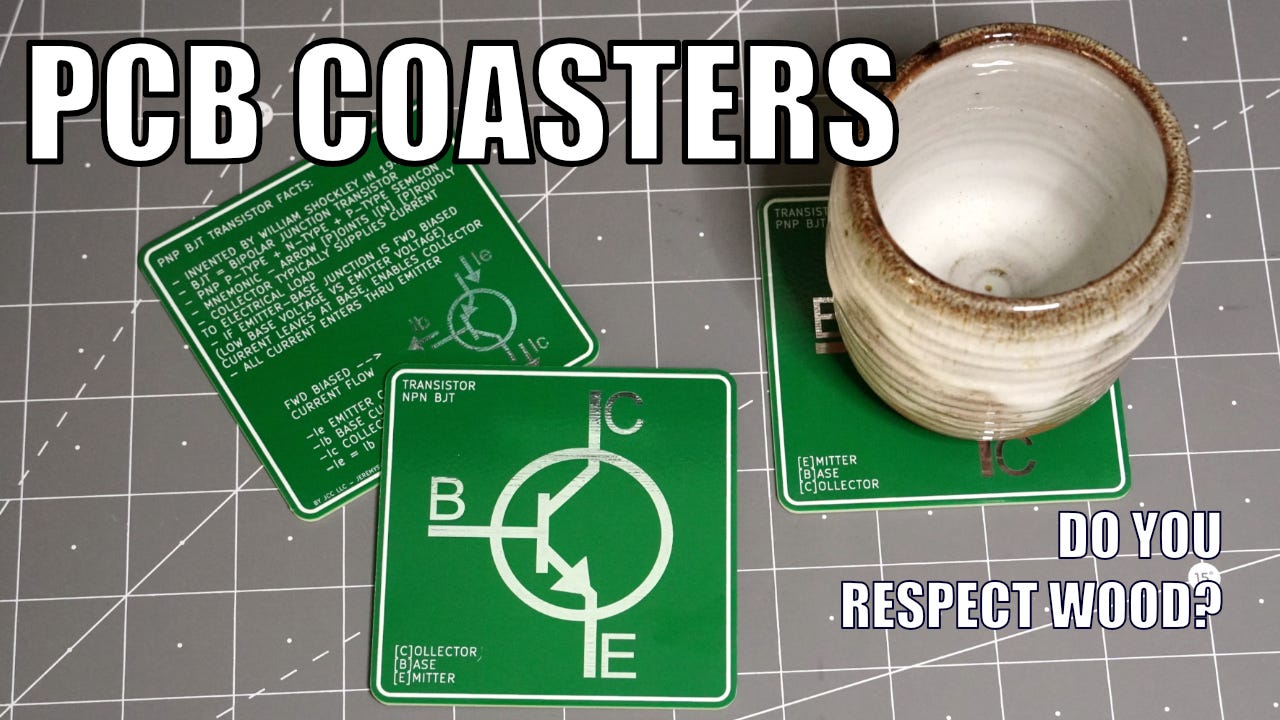Now Funding on Kickstarter: Transistor Drink Coaster PCBs!
Printed Circuit Boards as drink coasters? With transistor diagrams and facts on them? My new crowdfunding campaign!
Yesterday I put something up on Kickstarter: drink coasters 😲. But not just any drink coasters: These coasters are each made out out of printed circuit boards–PCBs if you so prefer.1–and decorated with a transistor symbol illustration on the front, plus facts about transistors on the back.
These are super-useful if you need to keep water off of your desk and simultaneously need a handy reference for how NPN and/or PNP BJT transistors work! If you’re already convinced that you need one, here’s the crowdfunding link.
Or read on for more details about the build:
Transistor coaster PCB idea/manufacturing
While PCBs are primarily used for circuits2, these PCBs are designed entirely for their artistic value, forgoing guided electron transmission or components whatsoever. I created these PCBs as 85x85 mm squares (roughly 3.35x3.35in) with rounded corners (for safety!?). Transistor diagrams are laid out in lead-free HASL or gold-based ENIG (the shiny part), while more info on transistor operation is printed in silk screen (i.e. white ink).
These 1.6mm thick PCBs are extremely tough, and they should do a great job of stopping water, while acting as a quick informational shortcut when you can’t quite remember pertinent facts about NPN or PNP BJT transistors. This might sound trivial if you’re an electrical engineer, but my degree is in mechanical engineering. I can use a hint once in a while when it comes to electronics.
Of course, the PCB coaster isn’t a new concept. In fact, I have one that acts as a sort of reference device for surface-mount technology (SMT) components. The PCB coaster isn’t my idea, but this design is.
Where/when can I get one?
I ordered five prototypes of both the NPN and PNP versions. As shown in the first image in this article, they look rather awesome (in my humble opinion). I also plan to make a gold/matte black “deluxe” version spinning above, which should be even better.
It’s a simple design, but something that might have mass, or at least tech-adjacent, appeal. With that in mind, I decided to do a Kickstarter crowdfunding campaign for these coasters, with a rather modest goal of raising $200 and an expected delivery in May of this year (2025).
Hopefully I will far exceed that amount. I would be honored if you’d like to help.
If you are interested in one, 👉 you can support me/this project here. 👈💰💰🫡 You’ll be able to respect wood, while remembering and visualizing how these (literally world-changing) devices work.
That was a shorter post for today, but hopefully you found it interesting. I was originally planning for this to be combined with more info/examples of PCB art, but I got such a fantastic response on BSKY when I asked about it, that I’m planning to make that a separate article.
Of course, this isn’t my first Kickstarter rodeo (it’s my second). I touch on this in my previous article: It’s Never Been Easier to Make Your Product a Reality If you’re on the fence about producing your own gadget, now is the time! -JC
Note that any Amazon links are affiliate
Addendum/Footnotes:
This intro was initially more boring, but now after maybe too much caffeine and watching this weird and inappropriate video for inspiration/procrastination, it’s become a bit more lively. Also, is it really a “PCB?” It’s definitely printed, and it is a board, but in reality there are no circuits involved. So more of a “PB” if we want to be literal.
I.e. printed circuit boards. The bulk of a PCB is made from fiberglass, straddled by layers of copper, polymer (solder mask), and ink (silkscreen) that can be transformed into whatever shape you want, in this case art/illustrations.
PCBs are typically designed using an EDA (Electronic Design Automation) package, meant to carve circuits on the copper layer, while exposing copper where required to accommodate chips like microcontrollers and resistors. I used a program called KiCad for this design, along with graphics package Affinity Designer 2 to make the actual graphics.
I made the symbols, and I released them here as public domain. Seemed like the symbols that I could find were either not quite what I wanted, or they had some sort of claimed license. So there you go world.




